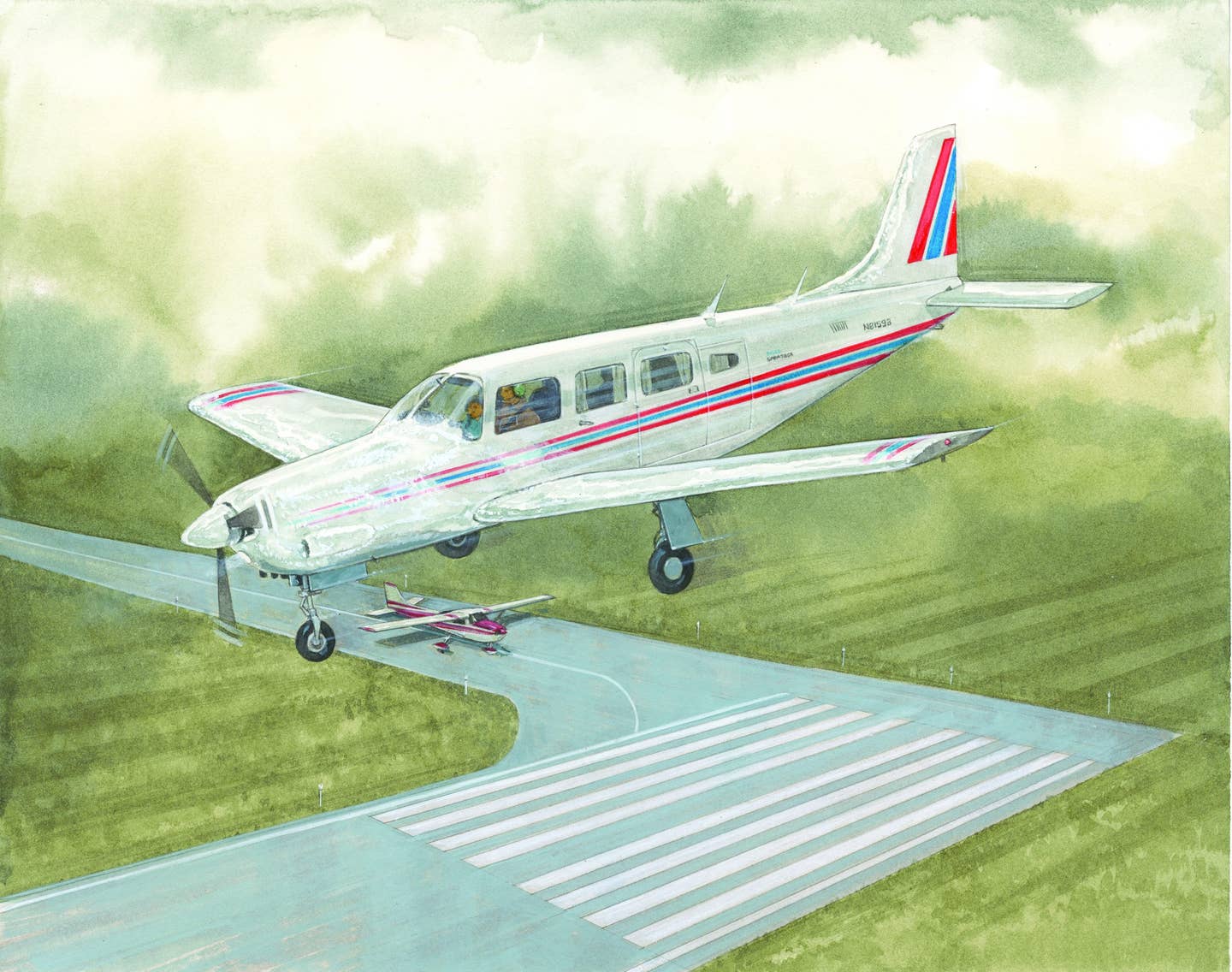
To see more of Barry Ross’ aviation art, go to barryrossart.com Barry Ross
My wife was loading the Freedom Machine with luggage and our three young sons as I entered the Greater Cincinnati FBO to file IFR for the flight back to Cleveland. A TV with the Bengals-Browns game caught my attention. It was the close-up of a Browns lineman with a wet jersey filling the screen that sent up a red flag. "Hmm …" I thought. "It was supposed to be sunny all weekend."
The day before was sunny and warm — a beautiful T-shirt day in mid-October. It was a family getaway to celebrate both the move up from a Warrior to a Saratoga and my new instrument ticket. But today the Cleveland weather was calling for some light precipitation with temperatures in the mid-40s and patches of marginal VFR. It was nothing serious, the briefer assured me. With the intense instrument training my instructor, Ray, had put me through, a few clouds would be a piece of cake to dip my toes into single-pilot IFR. I felt confident, but that image of the wet Browns player was an ominous warning sign in the back of my mind. The preflight seemed to take forever as I double-checked everything. This might be the real deal: actual IFR. Let’s roll.
As the prop bit into the air on takeoff, I listened intently to the roar of the Lycoming for any hint of sputter, shudder or hiccup. None. All was smooth. The 300 horses broke into a gallop, and in seconds, nothing but blue skies filled the windscreen.
Level at altitude, I finally began to relax and enjoy the scenery. I glanced back at Patty in the third seat, holding our 1-year-old, Victor. He had fallen asleep to the drone of the engine. Next to me, my little copilot Kevin’s head began to slump as his headset shifted. I couldn’t see our oldest, Brian, sitting in the back-facing middle seat, but I felt he was as content as the rest. Communications with ATC gave me a sense of security that we were being watched over.
Thirty minutes from Cleveland, near Mansfield, the windscreen went light gray. IMC flight: This is what I had trained for.
Mansfield Approach passed us off to Cleveland Approach. “Cleveland Approach, Saratoga eight one five niner three, with you level at 5,000, inbound Hopkins, IFR.” The handoff went smoothly, and I began to feel a sense of proud professionalism. I could really get to enjoy this instrument flying thing.
In the chatter on the frequency, I heard the controller advising an inbound flight to Burke Lakefront Airport that another pilot was reporting icing. I passed it off as local lake effect, and besides, that was 10 miles northeast of my destination. The air was smooth; the temperature above freezing; and Hopkins was only 20 minutes away. No problem.
FWAP! What was that? The airplane lurched. FWAP! FWAP! It was as if massive ice balls were being hurled at us. I was amazed that the windscreen was holding intact. Between the bouts of battering, I looked at the wings: ice — building fast! I reached for the pitot heat switch near my left arm — too late.
“Cleveland Approach, Saratoga five niner three, encountering severe icing. I lost my instruments!” My airspeed indicator was reading zero, the altimeter was fluctuating wildly, and the VSI was locked horizontal. My sole connection to outside reality was my attitude indicator. Just as my finger was hitting the pitot heat, a calm voice penetrated the frequency: “Tell him to turn on his pitot heat.” It was as if one of the “big boys” was in the cockpit with me. It was comforting.
During the crisis, events unfolded quickly. The ice was continuing to build. With the deluge of information flooding my brain, I began to lapse into tunnel vision.
I turned to look at my family. Kevin was thankfully asleep. I turned to look at Patty in the back. She knew that the situation was dire. Her eyes met mine — no words were necessary. She was clutching our little Victor. I couldn’t see Brian sitting behind me.
All through my training, my instructors drilled into me “aviate, navigate, communicate.” I focused intently, and the tunnel vision began to fade.
My instruments snapped back to life just as the controller called out my airspeed and altitude. That problem was solved, but I still had to contend with the ice.
“November five niner three, Cleveland Approach. Turn left heading 360. Prepare to intercept the ILS 7 localizer. Descend to 2,400 feet.” I began to fumble through the approach plates. I was behind the airplane, focused on ice, airspeed and altitude. Sensing this, the next communication came: “Saratoga five niner three, the frequency for the ILS 7 is 111.7.” I knew that — I just couldn’t think of it right now. Thanks.
Turning left and descending, I scarcely noticed that the slugs of slush had ceased. I glanced at the wings to see ice — lots of it. My God, what’s keeping this thing in the air?
“Five niner three, turn right, 325, intercept the localizer.” The needle was pegged hard right. I had blown through it. The understanding controller vectored me for a second attempt. This bought some time to catch up to the airplane. I set both nav radios to 111.7, the HSI to 70 degrees, and the altitude bug to 995 feet. I tucked the open approach plate book securely into my lap and locked onto the assigned vectors.
All was still gray outside. I was stable at 2,400 feet and well above the usual approach speed of 95 knots. I wasted no time in rolling onto the localizer heading. The DME let me know that the glideslope intercept was approaching. The thought of flaps conjured up a warning of ice jamming one side, flipping the airplane into a spin or a possible tailplane stall. No. With nearly a mile of runway, I’d come in hot with no flaps.
At this point, my focus was on keeping both needles centered, glancing at the altimeter for the big moment to arrive: decision height.
Passing through 2,000 feet, there was nothing but gray. I dared not lower the landing gear until the runway was in sight in the event of ice locking it up on the go-around. My eyes darted from HSI to altimeter to windscreen. Two hundred feet to DH — nothing. One hundred feet — still nothing. Fifty feet — where is that runway? Finally, exactly at decision height, there it was — straight in front of me. I pulled the gear lever and waited. And waited. I could see an airplane holding for takeoff on the taxiway. The runway got larger. Bing, bing. The green lights for the mains lighted up. Come on, come on. One more. Finally, bing. The nosewheel was down and locked. Long landing or not, this was it. “Cleveland Approach, Saratoga five niner three has the runway, cancel IFR. Thanks for all your help.”
The landing roll used up all but 200 of the 5,000 feet of asphalt available. As we turned onto the taxiway and headed back to the ramp, I was drained. All I remembered was the gratitude I had for our survival. “Five souls on board” took on a profound new meaning.
As the engine shut down, Kevin awoke next to me, his headset dangling around his neck. Blinking his big, blue eyes, he looked like an angel. I unfastened him and we exited the airplane. Raising my eyes, all I could say was “Thank you, thank you, thank you!”
Patty and Brian were already out. She was clutching Victor tightly. Just then, KACHUNK! A huge cowl-shaped block of ice smashed to the tarmac. In rapid succession, KACHUNK! and KACHUNK! Two long ribbons of ice from the leading edges of the wings followed suit. I picked up a foot-long chunk and stared at its cross section. Three and a half inches thick. How could an airplane fly with that much ice? I had no idea it was possible.
Back home, I called the Cleveland tower and found that the controller who had held my hand at altitude on my near-disastrous maiden IFR flight was still on duty. I thanked him for the five of us, and expressed gratitude to the “heavy iron” pilot who had given this rookie the fatherly advice to turn on my pitot heat. Those professionals, as well as all my instructors who took their time and patience to prepare me for this, came to our aid some 25 years ago and taught me the real meaning of aviation community, of which I’m proud to belong.

Sign-up for newsletters & special offers!
Get the latest FLYING stories & special offers delivered directly to your inbox






